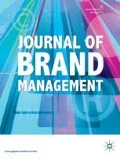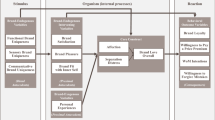Abstract
This research provides a comprehensive overview of the brand experience effects and proposes an extension to the brand experience model by testing novel direct, moderating, and mediating relationships. The authors conducted a meta-analysis of 256 quantitative studies in 73 papers published between 2009 and 2015. The findings reveal new empirical generalizations about the relationship between brand experience and the relevant constructs. The findings demonstrate the positive influence of brand experience on brand satisfaction and positive influence of brand satisfaction on brand trust, brand loyalty, and word-of-mouth (WOM). Furthermore, this research uncovers important mediation variables (hedonic benefits, brand love, and brand personality) of the relationship between brand experience and brand satisfaction. This paper also tests the moderation effects of methodological (e.g., sample type, sample size), theoretical (product type and product lifecycle), and cultural variables (e.g., level of innovation, level of wealth and Human Development Index). The findings extend the brand experience model, helping managers to understand the positive outcomes of brand experience on satisfaction and to invest in actions that can enhance the brand experience. Furthermore, this study shows that brand managers should consider culture is a key factor when crafting branding experience strategies.

Similar content being viewed by others
References
Aaker, J.L. 1997. Dimensions of brand personality. Journal of Marketing Research 34: 347–356.
Aaker, D.A., and M.B. Equity. 1991. Capitalizing on the value of a brand name. New York: The Free Press.
Aggrawal, P., and A.L. McGill. 2007. Is that car smiling at me? Schema congruity as a basis for evaluating anthropomorphized products. Journal of Consumer Research 34: 468–479.
Aron, A., and L. Westbay. 1996. Dimensions of the prototype of love. Journal of Personality and Social Psychology 70 (3): 535.
Babin, B.J., W.R. Darden, and M. Griffin. 1994. Work and/or fun: Measuring hedonic and utilitarian shopping value. Journal of consumer research 20 (4): 644–656.
Baron, R.M., and D.A. Kenny. 1986. The moderator–mediator variable distinction in social psychological research: Conceptual, strategic, and statistical considerations. Journal of Personality and Social Psychology 51 (6): 1173.
Batra, R., and O.T. Ahtola. 1991. Measuring the hedonic and utilitarian sources of consumer attitude. Marketing Letters 2 (2): 159–170.
Belk, R. W. (1984). Three scales to measure constructs related to materialism: Reliability, validity, and relationships to measures of happiness. ACR North American Advances.
Belk, R.W., K.D. Bahn, and R.N. Mayer. 1982. Developmental recognition of consumption symbolism. Journal of Consumer Research 9 (1): 4–17.
Berry, L.L., L.P. Carbone, and S.H. Haeckel. 2002. Managing the total customer experience. MIT Sloan Management Review 43 (3): 85.
Bertil, H. 2011. Sensory marketing: The multi-sensory brand-experience concept. European Business Review 23 (3): 256–273.
Bloemer, J.M., and H.D. Kasper. 1995. The complex relationship between consumer satisfaction and brand loyalty. Journal of Economic Psychology 16 (2): 311–329.
Brakus, J.J., B.H. Schmitt, and L. Zarantonello. 2009. Brand experience: What is it? How is it measured? Does it affect loyalty? Journal of Marketing 73 (3): 52–68.
Brown, T.J., T.E. Barry, P.A. Dacin, and R.F. Gunst. 2005. Spreading the word: Investigating antecedents of consumers’ positive word-of-mouth intentions and behaviors in a retailing context. Journal of the Academy of Marketing Science 33 (2): 123–138.
Carroll, B.A., and A.C. Ahuvia. 2006. Some antecedents and outcomes of brand love. Marketing Letters 17 (2): 79–89.
Chaudhuri, A., and M.B. Holbrook. 2001. The chain of effects from brand trust and brand affect to brand performance: The role of brand loyalty. Journal of Marketing 65 (2): 81–93.
Chen, H., A. Papazafeiropoulou, T.K. Chen, Y. Duan, and H.W. Liu. 2014. Exploring the commercial value of social networks: Enhancing consumers’ brand experience through Facebook pages. Journal of Enterprise Information Management 27 (5): 576–598.
Cheung, M.W.L. 2015. Meta-analysis: A structural equation modeling approach. Chichester: Wiley.
Churchill, Gilbert A. 1999. Marketing research: Methodological foundation. Orlando: The Dryden Press.
Crosno, J.L., and R. Dahlstrom. 2008. A meta-analytic review of opportunism in exchange relationships. Journal of the Academy of Marketing Science 36 (2): 191–201.
Delgado-Ballester, E., and J. Luis Munuera-Alemán. 2001. Brand trust in the context of consumer loyalty. European Journal of Marketing 35 (11/12): 1238–1258.
Ding, C.G., and T.H. Tseng. 2015. On the relationships among brand experience, hedonic emotions, and brand equity. European Journal of Marketing 49 (7/8): 994–1015.
Eisend, M., and N.E. Stokburger-Sauer. 2013. Brand personality: A meta-analytic review of antecedents and consequences. Marketing Letters 24 (3): 205–216.
Fern, E.F., and K.B. Moroe. 1996. Effect-size estimates: Issues and problems in interpretation. Journal of Consumer Research 23 (2): 89–105.
Forsido, M. 2012. Brand loyalty in Smartphone (Doctoral dissertation, Master Thesis Uppsala Universitet, Sweden).
Francisco-Maffezzolli, E.C., E. Semprebon, and P.H.M. Prado. 2014. Construing loyalty through brand experience: The mediating role of brand relationship quality. Journal of Brand Management 21 (5): 446–458.
Geyskens, I., R. Krishnan, J.B.E. Steenkamp, and P.V. Cunha. 2009. A review and evaluation of meta-analysis practices in management research. Journal of Management 35: 393–419.
Green, S. 2005. Systematic reviews and meta-analysis. Singapore Medical Journal 46 (6): 270.
Grönroos, C. 2000. Creating a relationship dialogue: Communication, interaction and value. The marketing review 1 (1): 5–14.
Ha, H.Y., and H. Perks. 2005. Effects of consumer perceptions of brand experience on the web: Brand familiarity, satisfaction, and brand trust. Journal of Consumer Behaviour 4 (6): 438–452.
Hedges, L.V., and I. Olkin. 1985. Statistical methods for meta-analysis. Orlando, FL: Academic Press. ISBN 9780123363800.
Hunter, J.E., and F.L. Schmidt. 2004. Methods of meta-analysis: Correcting error and bias in research findings. Thousand Oaks: Sage.
Iglesias, O., J.J. Singh, and J.M. Batista-Foguet. 2011. The role of brand experience and affective commitment in determining brand loyalty. Journal of Brand Management 18 (8): 570–582.
Jones, M.A., K.E. Reynolds, and M.J. Arnold. 2006. Hedonic and utilitarian shopping value: Investigating differential effects on retail outcomes. Journal of Business Research 59 (9): 974–981.
Jung, L.H., and K.M. Soo. 2012. The effect of brand experience on brand relationship quality. Academy of Marketing Studies Journal 16 (1): 87.
Khan, I., and Z. Rahman. 2015. Brand experience anatomy in retailing: An interpretive structural modeling approach. Journal of Retailing and Consumer Services 24: 60–69.
Kim, R., D.H. Yoon, Y. Chao, and N. Dang. 2015. Effects of brand experience and product involvement on brand loyalty for vietnamese consumers. DLSU Business & Economics Review 25 (1): 1–15.
Kumar, S.R., S. Dash, and P. Chandra Purwar. 2013. The nature and antecedents of brand equity and its dimensions. Marketing Intelligence & Planning 31 (2): 141–159.
Kwong, M.Z., and I. Candinegara. 2014. Relationship between brand experience, brand personality, consumer satisfaction, and consumer loyalty of DSSMF brand. Buss Management 2 (2): 59–98.
Lipsey, M.W., and D.B. Wilson. 1993. The efficacy of psychological, educational, and behavioral treatment: Confirmation from meta-analysis. American Psychologist 48 (12): 1181.
Lipsey, M.W., and D.B. Wilson. 2001. Practical meta-analysis, vol. 49. Thousand Oaks, CA: Sage Publications.
Mano, H., and R.L. Oliver. 1993. Assessing the dimensionality and structure of the consumption experience: Evaluation, feeling, and satisfaction. Journal of Consumer Research 20: 451–466.
McCrae, R.R., and P.T. Costa Jr. 1997. Personality trait structure as a human universal. American Psychologist 52 (5): 509.
Minkov, M. 2011. Cultural differences in a globalizing world. Emerald: Bingley.
Morgan, R.M., and S.D. Hunt. 1994. The commitment-trust theory of relationship marketing. The Journal of Marketing 58: 20–38.
Morrison, S., and F.G. Crane. 2007. Building the service brand by creating and managing an emotional brand experience. Journal of Brand Management 14 (5): 410–421.
Mosley, R.W. 2007. Customer experience, organisational culture and the employer brand. Journal of Brand Management 15 (2): 123–134.
Nysveen, H., P.E. Pedersen, and S. Skard. 2013. Brand experiences in service organizations: Exploring the individual effects of brand experience dimensions. Journal of Brand Management 20 (5): 404–423.
Oliver, R.L. 1980. A cognitive model of the antecedents and consequences of satisfaction decisions. Journal of Marketing Research 17: 460–469.
Oliver, R.L. 1981. Measurement and evaluation of satisfaction processes in retail settings. Journal of Retailing 57: 25–48.
Oliver, R.L. 1993. Cognitive, affective, and attribute bases of the satisfaction response. Journal of Consumer Research 20: 418–430.
Oliver, C. 1997. Sustainable competitive advantage: Combining institutional and resource-based views. Strategic Management Journal 18: 697–713.
Olson, J.C., and A.A. Mitchell. 2000. Are product attribute beliefs the only mediator of advertising effects on brand attitude? Advertising & Society Review 1 (1): 318–322.
Palmatier, R.W., R.P. Dant, D. Grewal, and K.R. Evans. 2006. Factors influencing the effectiveness of relationship marketing: A meta-analysis. Journal of Marketing 70 (4): 136–153.
Pan, Y., and G.M. Zinkhan. 2006. Determinants of retail patronage: A meta-analytical perspective. Journal of Retailing 82 (3): 229–243.
Ramaseshan, B., and A. Stein. 2014. Connecting the dots between brand experience and brand loyalty: The mediating role of brand personality and brand relationships. Journal of Brand Management 21: 664–683.
Robinson, K.A., and K. Dickersin. 2002. Development of a highly sensitive search strategy for the retrieval of reports of controlled trials using PubMed. International Journal of Epidemiology 31 (1): 150–153.
Rosenthal, R. 1979. The file drawer problem and tolerance for null results. Psychological bulletin 86 (3): 638.
Rosenthal, R., and D.B. Rubin. 1991. A simple general purpose display of magnitude and experimental effect. Journal of Educational Psychology 74 (2): 166–169.
Rust, R.T., and B. Cooil. 1994. Reliability measures for qualitative data: Theory and implications. Journal of Marketing Research 31: 1–14.
Sabiote, E., and M.E. Ballester. 2011. Marcas de experiencia: Marcando la diferencia. Estudios Gerenciales 27 (121): 59–78.
Sarkar, A., A. Ponnam, and B.K. Murthy. 2012. Understanding and measuring romantic brand love. Journal of Customer Behaviour 11 (4): 324–347.
Schmitt, Bernd H. 1999. Experiential marketing: how to get customers to sense, feel, think, act, relate to your company and brands. New York: The Free Press.
Sirdeshmukh, D., J. Singh, and B. Sabol. 2002. Consumer trust, value, and loyalty in relational exchanges. Journal of Marketing 66 (1): 15–37.
Voss, K.E., E.R. Spangenberg, and B. Grohmann. 2003. Measuring the hedonic and utilitarian dimensions of consumer attitude. Journal of Marketing Research 40 (3): 310–320.
Yoo, B., and N. Donthu. 2001. Developing and validating a multidimensional consumer-based brand equity scale. Journal of Business Research 52 (1): 1–14.
Yoo, B., N. Donthu, and S. Lee. 2000. An examination of selected marketing mix elements and brand equity. Journal of the Academy of Marketing Science 28 (2): 195–211.
Young, E. 2006. In: Global stell—2015–2016. http://www.ey.com/gl/en/industries/mining-etals/ey-global-steel-2015-2016
Zarantonello, L., K. Jedidi, and B.H. Schmitt. 2013. Functional and experiential routes to persuasion: An analysis of advertising in emerging versus developed markets. International Journal of Research in Marketing 30 (1): 46–56.
Author information
Authors and Affiliations
Corresponding author
Rights and permissions
About this article
Cite this article
de Oliveira Santini, F., Ladeira, W.J., Sampaio, C.H. et al. The brand experience extended model: a meta-analysis. J Brand Manag 25, 519–535 (2018). https://doi.org/10.1057/s41262-018-0104-6
Revised:
Published:
Issue Date:
DOI: https://doi.org/10.1057/s41262-018-0104-6




